What Animals Will Eat A Monarch Chrysalis
This mail service may comprise affiliate links to our partners like Chewy, Amazon, and others. Purchasing through these helps the states further the A-Z Animals mission to educate about the earth's species..
The food a Monarch eats as a caterpillar will provide the fuel for their migration equally an developed butterfly.
Monarch Butterflies are known for their very distinct orange, blackness, and white coloring. These astonishing creatures go through four stages in their life bicycle: egg, larvae, pupa, and adult. While some developed monarch collywobbles may only alive for two to half-dozen weeks, during migration they can live for eight or ix months. When they migrate in the autumn, a Monarch Butterfly will travel thousands of miles. And, while they fly on their own during the day, they volition form large groups, known as roosts, at dark.
Incredible Monarch Butterfly Facts!
• The four stages in the life bike of a Monarch Butterfly are egg, larvae, pupa, and developed.
• Monarchs accept black, orange, and white coloring which makes them piece of cake to identify.
• During migration, Monarchs may fly thousands of miles.
• Losing their habitats is one of the biggest threats faced by Monarchs.
• Female Monarchs lay their eggs on milkweed plants.
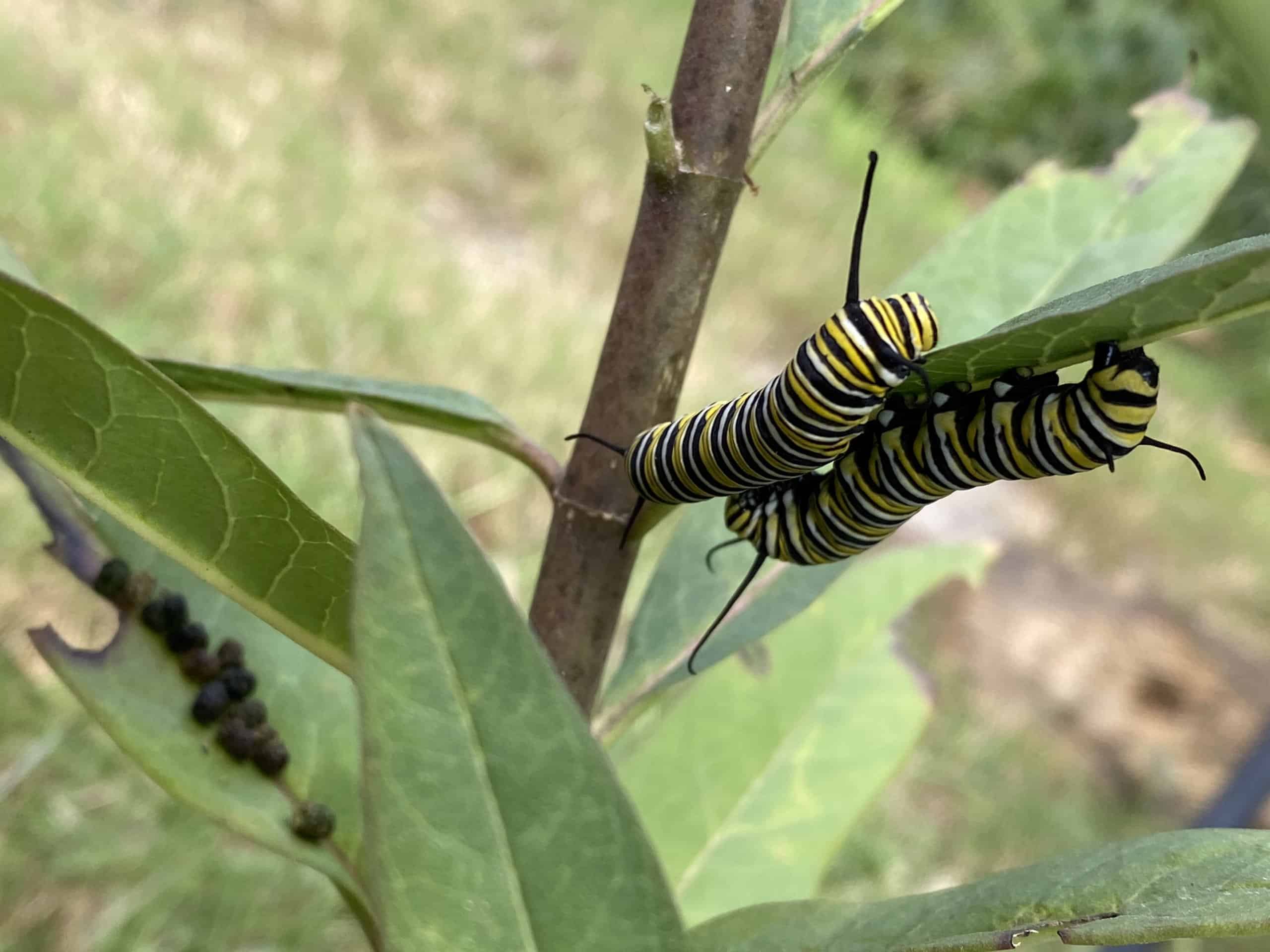
Monarch Butterfly Scientific proper name
Monarch Butterflies are in the Insecta Class and vest to the Nymphalidae Family. Their scientific name is Danaus plexippus. Danaus refers to a genus of butterflies and plexippus refers to the specific Monarch Butterfly species.
There are three species of Monarch Butterflies. In add-on to Danaus plexippus plexippus (the North American Monarch Butterfly), the other two species are Danaus erippus (the Southern Monarch Butterfly) and Danaus cleophile jamaicensis (the Jamaican Monarch Butterfly).
Monarch Butterfly Appearance and Beliefs
Monarch Butterflies have a very distinct appearance which makes them easy to place. The acme portion of their wings are orange with black veins, numerous white spots around the perimeter of the wings, and a few orangish spots near the tips of the wings. The underside of a Monarch Butterfly's wings looks similar to the upper side. Nevertheless, instead of being a vivid orange color, the wings are more of a yellow-brown colour. The white spots on the undersides of their wings are larger than the ones plant on the upper sides.
Throughout the migration flavour, the wings of dissimilar Monarch Collywobbles may have a different appearance. Towards the beginning of the migration, a Monarch's wings expect to be longer and redder than those of Monarchs migrating later in the flavor. Additionally, the wings of Monarchs who migrate and those who do not besides have slight differences.
A Monarch Butterfly'due south wingspan is between 3.5 and iv inches wide, this is as broad or a lilliputian wider than the average width of an developed male's mitt.
California Tortoiseshell Butterflies, Painted Lady Collywobbles, Western Tiger Swallowtail Butterflies, Viceroy Butterflies, and Queen Collywobbles all may be confused for Monarchs because of their like coloring. All of these butterflies, forth with Monarchs, accept bright colors on their wings which serve to warn predators that they are toxic and should not be eaten.
Monarch Butterflies are active during the day. North American Monarchs migrate north and s each year. They may travel thousands of miles for their migration. When migrating, they wing alone, however at nightfall, they come down to form a large grouping with other Monarchs known as a roost or a bivouac. Roost are ofttimes plant in trees that volition offer the butterflies shelter to offering them protection from predators and the elements. They will also be located near a nectar source.
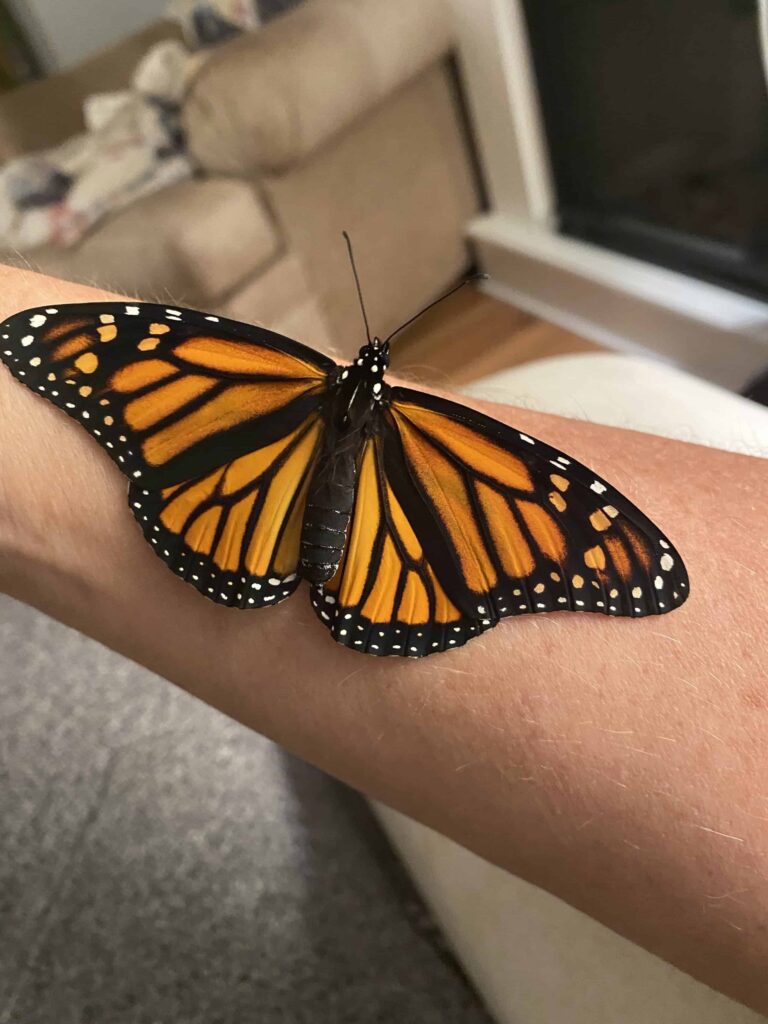
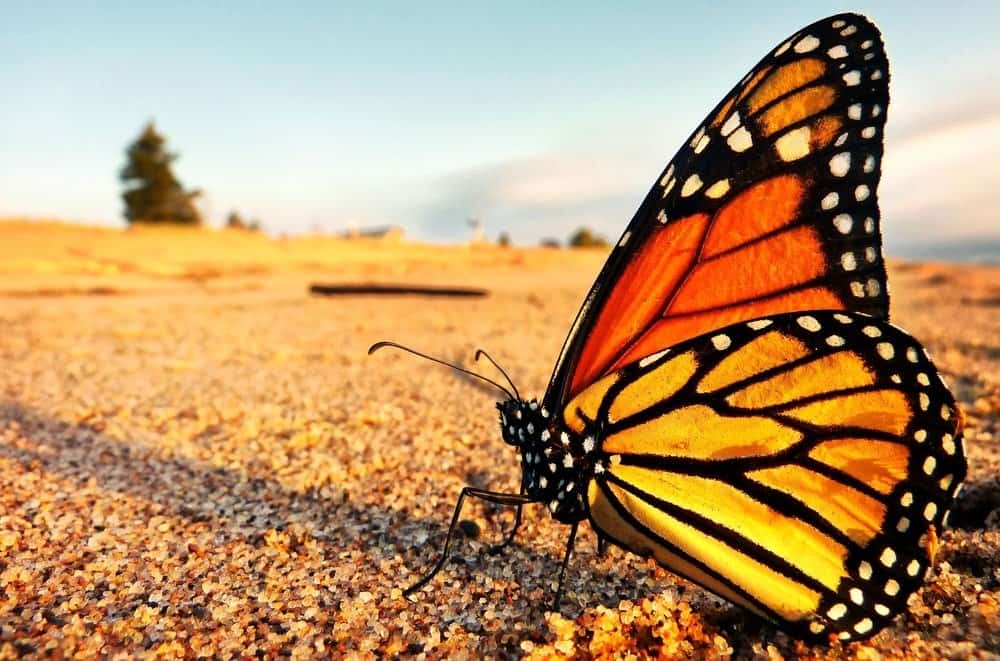
Chris Frost/Shutterstock.com
Monarch Butterfly Habitat
The N American Monarch Butterfly, Danaus Plexippus Plexippus, tin can exist in different areas across the continent. There are both western and eastern populations of this species. Monarchs can be constitute betwixt southern Canada and norther South America. This species as well has been spotted in diverse islands including Bermuda, the Melt Islands, Hawaii, Australia, New Zealand, Papua New Guinea, the Canary Islands, and the Solomon Islands.
Overwintering groups of Monarch Butterflies accept also been found in Florida, Arizona, California, and United mexican states. When choosing an overwintering location, Monarchs look for a habitat that will provide them with access to streams, abundant sunlight, and vegetation. They too choose areas that do not take many predators.
When overwintering, Monarchs may stay on different plants or tress, such every bit elms, locusts, oaks, sumacs, basswoods, cottonwoods, or mulberries. When Monarchs are breeding, their habitats generally consist of trees, gardens, and residential areas. When breeding, finding an area with larval host plants where they can lay their eggs is important to the butterflies.
Monarch Butterfly Diet
The diet of Monarch Butterfly larvae, or caterpillars, differs significantly from that of developed Monarch Collywobbles. Monarch lay their eggs on plants that the larvae will exist able to eat after hatching. These host plants include California milkweed, woolly pod milkweed, poke milkweed, swamp milkweed, Arizona milkweed, butterfly weed, whorled milkweed, Caribbean milkweed, rush milkweed, and showy milkweed.
Developed Monarch Butterflies savour nectar from a diversity of dissimilar plants. Some of these plants include milkweeds, teasel, coneflowers, alfalfa, lilac, tail ironweed, wild carrot, matriarch's rocket, and Indian hemp. Monarchs besides engage in mud-puddling, which is a behavior Monarch's engage in to go wet and minerals from wet gravel and clammy soil.
Monarch Butterfly Predators and Threats
There is fear that the Monarch Butterfly may be increasingly threatened due to failing population numbers. Every bit of 2014, the number of Monarch Butterflies that could be plant west of the Rocky Mountains had declined past more than 90% since 1995. Another study released in February of 2015 by the U.S. Fish and Wildlife Service showed that near one billion monarchs had disappeared from their overwintering locations since 1990.
One threat that has led to a decline in the number of Monarch Butterflies is loss of their habitats acquired past the use of herbicides. Species of milkweed plants, where the Monarchs lay their eggs and potable nectar, have been decreasing. Between 120 and 150 million acres of milkweeds in the Midwest have been eliminated.
Another threat faced by Monarchs is being killed by auto strikes. According to a 2019 study in northern Mexico, it was estimated that 200,000 Monarchs were killed by vehicle strikes each yr in just two different 'hotspot' locations.
In addition to these human-based threats to Monarch butterflies, they also have some natural predators. However, their natural predators do not pose the aforementioned threat to the overall population of the collywobbles that human-made causes practise.
Even though many Monarchs in both the larvae and adult stages are toxic to many species, there are a few birds who take learned which parts are rubber to consume. Some other birds have acquired unlike capabilities of identifying which parts of the Monarchs are safe to swallow or dangerous based on the taste. Robins, sparrows, pinyon jays, orioles, thrashers, and some other birds pretty on larvae and adult Monarchs.
Other natural predators include mice, the Chinese Mantis, the Asian Lady Beetle, and Wasps
Currently, Monarch Butterflies are not listed as an endangered or protected species. However, many scientists and others are concerned about Monarch Collywobbles and their declining numbers. A review of their status was initiated by the U.S. Fish and Wild fauna Service in 2015. A decision almost whether to upgrade their status is expected in December of 2020.
Monarch Butterfly Reproduction and Life Bike
Male and female monarch butterflies usually mate several times. The more times they mate, the more eggs females will lay. Monarchs in overwintering populations typically mate in the leap. Dissimilar other butterfly species, Monarchs are not every bit dependent on pheromones for mating.
When looking for a mate, male Monarchs will find a female, follow her, and may fifty-fifty forcefulness her down to the ground. One time on the footing, the male and the females will often copulate and will stay fastened to each other for between 30 and threescore minutes. Withal, not all mating attempts upshot in copulation. When a male and female Monarch copulate, the male transfers both sperm and spermatophore to the female person. The spermatophore gives boosted nutrition to the female to help her lay more eggs.
Different factors can touch the size of the eggs a female will lay. Smaller females and those who are older typically lay smaller eggs than larger or younger adult females. Considering females mate more than once, they may lay anywhere betwixt 290 and 1180 eggs throughout the class of their life.
In that location are iv stages in the life cycle of a Monarch Butterfly. They are: egg, larvae, pupa, and developed. Adult Monarchs lay their eggs on the underside of a foliage of a host plant, such every bit milkweed. The eggs are near often laid during bound and summer. Monarch eggs are very small. They are only well-nigh 1.2 x 0.9 millimeters and counterbalance less than .5 milligrams. The eggs are oval-shaped and eight light green or cream-colored. Once laid, the eggs will take between 3 and 8 days to cease developing. At that point, they volition hatch.
The next phase in the life cycle of a Monarch Butterfly is the larvae stage. More ordinarily referred to as caterpillars, larvae go through five unlike stages of growth. They start at just two to 6 millimeters in length, and past the terminate of the fifth phase, they are around 4.v centimeters long. Between each of these stages, the caterpillar molts its peel. As the larvae progress through the v stages, they develop a distinct white, yellow, and black striped pattern. During the fifth stage, the larvae eat a lot. By the cease of the stage, they will have increased their weight by 2,000 times from when they starting time emerged from the leaf.
Next, the larvae prepare for the tertiary stage in the life bicycle, which is the pupa stage. The caterpillar spins a silk pad where they can hang upside down. They attach themselves to their pad and form a J-shape. They stay in this J-shape for 12 to 16 hours, later on which time the caterpillar goes into peristalsis. The skin behind their head splits, and they shed their skin. This leaves a dark-green chrysalis, or pupa. Over time, the chrysalis hardens and get less fragile. Inside the chrysalis, the adult butterfly forms. Shortly before the Monarch is gear up to emerge from the pupa, the chrysalis volition become translucent and eventually transparent.
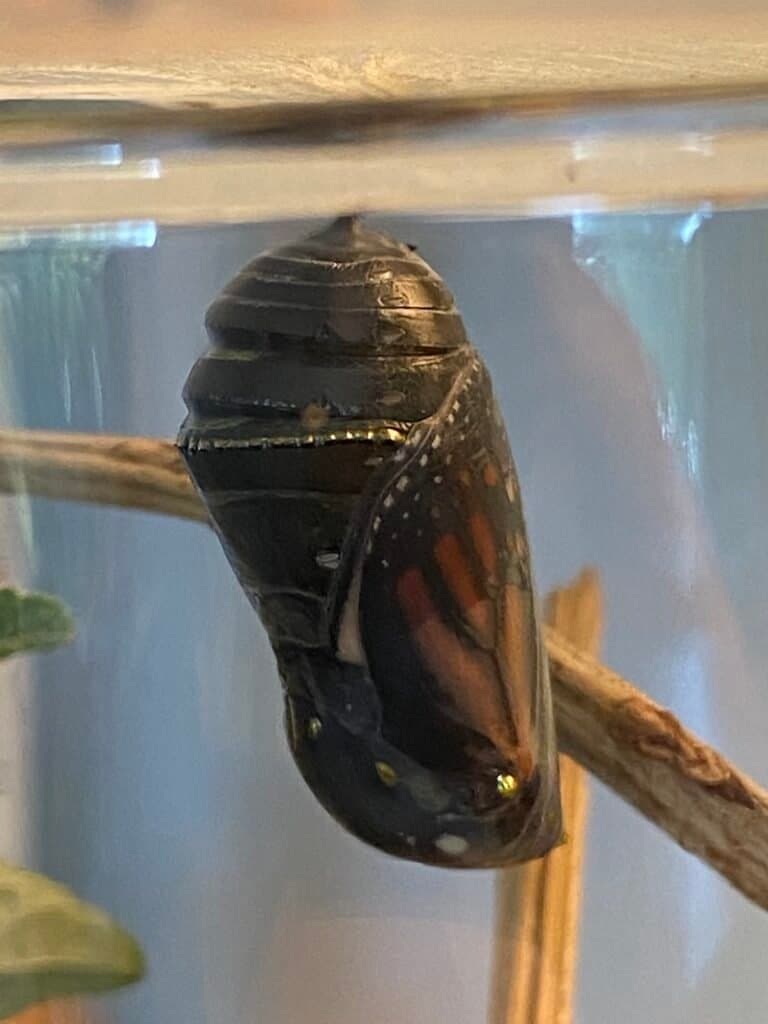
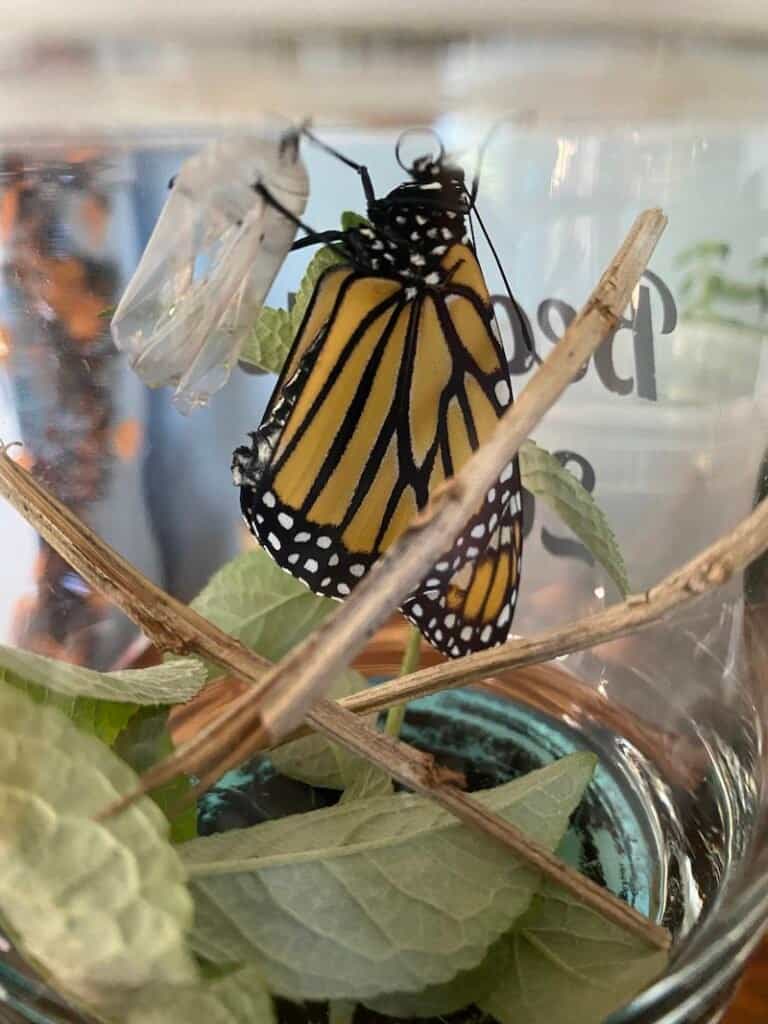
Monarchs stay in the pupa stage for effectually ii weeks. In one case they sally, they will initially hang upside downwards to allow their wings to dry. The wings will dry out out, stiffen, and expand when the butterfly pumps fluids into them. One time able to fly, the butterfly volition find nectar to feed on. Adult Monarch Butterflies reach sexual maturity during the breeding season by the time they are iv to 5 days one-time. Migrating Monarchs will not attain sexual maturity until overwintering is finished, nevertheless.
During the breeding flavor, most Monarch Butterflies live between 2 and five weeks. The last generation of the season that migrates can live for upwards to ix months.
Monarch Butterfly Population
Even though Monarch Butterflies are not listed every bit endangered, their numbers have been decreasing due to threats such as habitat loss. There are currently less than thirty,000 Danaus plexippus plexippus (Due north American Monarch Collywobbles) left.
View all 114 animals that beginning with Yard
Monarch butterflies are herbivores; they get their nutrients from plants.
North American Monarch Butterflies are found in many different areas across the continent of North American. Populations be in both the eastern and western parts of North America. They can also be found on many islands including Australia, New Zealand, Hawaii, Bermuda, and the Canary Islands.
During the breeding flavour, Monarch Collywobbles volition alive for between 2 and 6 weeks. During migration, they can live for up to nine months.
Monarch Butterfly eggs are very minor at just near i.2 by 0.9 millimeters. The eggs are either light green or cream-colored and have a conical shape.
While Monarch Butterflies are not currently considered endangered, their numbers have been decreasing over the by several years. It is estimated that there are merely around 30,000 Monarchs.
Monarch Butterflies have a wingspan that is between iii.5 and 4 inches.
It takes near xxx days from the time an egg is laid until an adult butterfly emerges from the chrysalis.
During her life, a female Monarch Butterfly will lay between 290 and 1180 eggs.
Yes, Monarchs hide for between six and eight months. Depending on where Monarchs migrate from, they may either hibernate in Mexico or California over the winter months.
Monarch Collywobbles belong to the Kingdom Animalia.
Monarch Collywobbles vest to the phylum Arthropoda.
Monarch Collywobbles belong to the class Insecta.
Monarch Butterflies belong to the family Nymphalidae.
Monarch Collywobbles belong to the order Lepidoptera.
Monarch Butterflies are covered in Scales.
Predators of Monarch Butterflies include birds (including robins, cardinals, sparrows, pinyon jays, and orioles), mice, Chinese mantis, and Asian Lady Beetles.
The scientific name for the Monarch Butterfly is Danaus plexippus.
At that place are three species of Monarch Butterfly.
A baby Monarch Butterfly is called a larva or caterpillar.
The biggest threat to Monarch Butterflies is habitat loss.
The Monarch Butterfly is as well called the milkweed, black veined chocolate-brown, common tiger, or wanderer.
During migration, Monarch Butterflies may travel 250 or more miles each day.
A Monarch Butterfly can travel at speeds of upwardly to 12 miles per hour.
Monarch Butterflies lay eggs.
The key differences between a queen butterfly and a monarch are their courting behavior, temperament, morphology, and flying speed.
Although they are so much akin, the queen butterfly has white spots on its hind wings that distinguish it from the monarch. You lot can easily tell the 2 species apart when their wings are open..
Source: https://a-z-animals.com/animals/monarch-butterfly/
Posted by: sublettandere.blogspot.com

0 Response to "What Animals Will Eat A Monarch Chrysalis"
Post a Comment